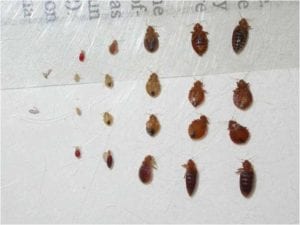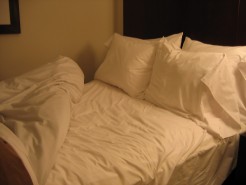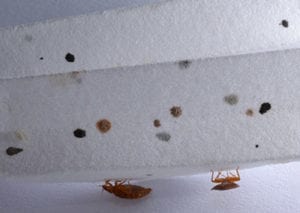It’s Bed Bug Awareness Week, as declared by our National Pest Management Association. There’s no better time than now to brush up on what you know and thought you knew about bed bugs. We’ve put together some of the most frequently asked bed bug questions (bed bug FAQ) we hear. We believe that education is the first defense against any pest problem. Let’s dive in!
WHAT DO BED BUGS LOOK LIKE?
Adult bed bugs are brown, about a quarter of an inch in diameter, and resemble a flat apple seed or lentil. Take a look at this image below. It shows 
HOW PERVASIVE IS THE BED BUG PROBLEM IN THE UNITED STATES?
There has been a significant increase in bed bug infestations in recent years. According to research conducted by the National Pest Management Association (NPMA), 97% of pest professionals treated for bed bugs in 2018.
WHY ARE BED BUGS SUCH A PROBLEM NOW?
While there is not one clear answer for the resurgence in bed bugs in recent years, the majority of pest professionals point to increased travel, lack of public awareness, and changing pest control products and methods. Vacations haven’t exactly been happening since the pandemic happened, but we’re all going to be itchy to go on one and will need to be prepared so we don’t bring them back home with us from anywhere.
WHAT STATES HAVE BEEN AFFECTED?
Pest control companies have reported bed bug activity on a national scale. Today, bed bugs can be found throughout almost every region of the world and in all 50 United States. Even. Alaska.
WHERE ARE BED BUGS FOUND?
Bed bugs are not limited to any one specific type of dwelling. Pest control companies have been reporting infestations everywhere including single-family homes, multi-family housing, apartments, hotels and motels, hospitals, schools and college campuses, office buildings, retail stores, movie theaters, libraries, and even public transportation. Wherever people are, bed bugs are possible.
ARE BED BUGS JUST IN BEDS?
While bed bugs are most often found in bed parts, such as mattresses, box springs, and folded areas, they can also survive in alternative habitats. Bed bugs often conceal themselves behind baseboards, wallpaper, upholstery, picture frames, electrical switch plates and in furniture crevices close to where they’ll be feeding. They can detect heat signatures and carbon dioxide emissions, so if you sleep on a couch in the living room and not in a bed in a bedroom, you can still have bed bugs. They’ll just go wherever you spend long periods of time in a stationary position so their feeding is optimal.
WHAT ARE SOME COMMON SIGNS OF A BED BUG INFESTATION?
Telltale signs of a bed bug infestation include:
- Small red to reddish brown fecal spots on mattresses, upholstery, or walls
- Molted bed bug skins, white, sticky eggs, or empty eggshells
- Very heavily infested areas may have a characteristically sweet odor
- Red, itchy bite marks, especially on the legs, arms, and other body parts which may be exposed while sleeping
WHY ARE BED BUGS SO HARD TO TREAT?
Bed bugs are elusive, hardy pests that are easily transported from one place to another. They can live for several months without eating and can withstand a wide range of temperatures from nearly freezing to almost 122 degrees Fahrenheit.
HOW DOES SOMEONE CONTROL BED BUGS?
Identifying a bed bug presence is the first step to solving the problem. If you do suspect you have bed bugs, contact a professional. An effective bed bug control strategy should start with a careful, thorough inspection by a licensed pest professional of all known and suspected spots where the bugs may be hiding. This is not a pest that can be controlled effectively with do-it-yourself measures. This is because they’re very resilient to products and can spread very quickly if not contained responsibly.
However, once bed bugs are identified and the situation has been evaluated, a pest professional will develop a treatment and control strategy depending on the extent of the infestation. It is imperative for the customer to fully follow the advice, including removing infested items and laundering clothing. Controlling bed bugs takes an active cooperative partnership between the pest expert and the customer.
Bed Bugs are NOT a DIY pest. Essential oils, rubbing alcohol, and any other number of “home remedies” seen on the internet can worsen the problem and cause more dangerous health threats than the insect infestation itself.
Think you may have a problem? Let us help you and check out our Bed Bug Solutions!




